PONTIAC PONTIAC 1997 Repair Manual
Manufacturer: PONTIAC, Model Year: 1997, Model line: PONTIAC, Model: PONTIAC PONTIAC 1997Pages: 419, PDF Size: 19.67 MB
Page 61 of 419
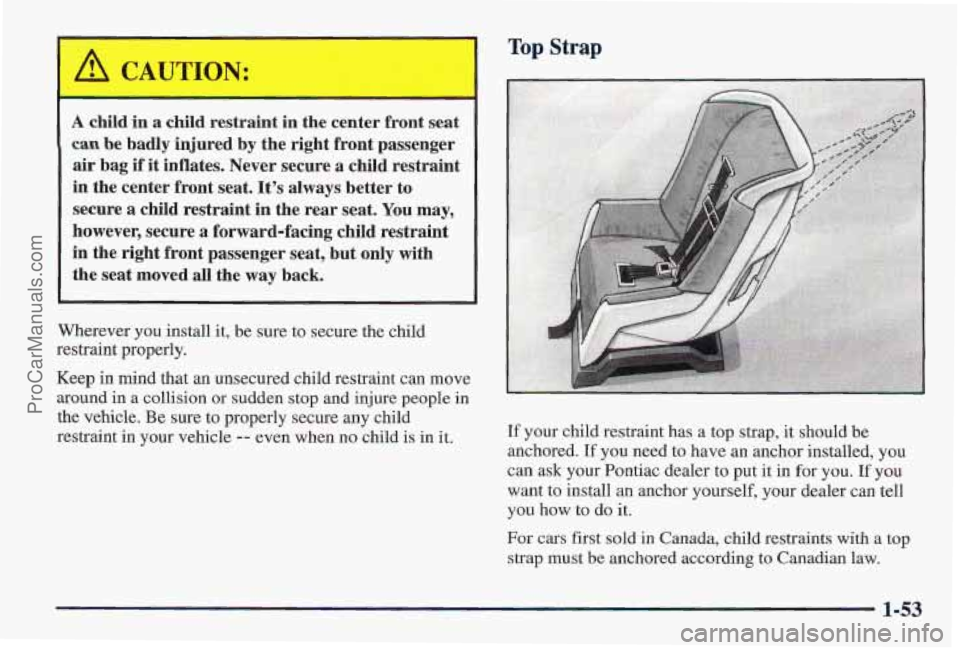
A child in a child restraint in the center front seat
can be badly injured by the right front passenger
air bag
if it inflates. Never secure a child restraint
in the center front seat.
It’s always better to
secure a child restraint in the rear seat. You may,
however, secure a forward-facing child restraint
in the right front passenger seat, but only
with
th’e seat moved all the way back.
Wherever you install it, be sure to secure the child
restraint properly.
Keep in mind that an unsecured child restraint can move
around in a collision or sudden stop and injure people in
the vehicle. Be sure to properly secure any child
restraint in your vehicle
-- even when no child is in it.
Top Strap
I
If your child restraint has a top strap, it should be
anchored. If you need to have an anchor installed, you
can ask your Pontiac dealer to put it in for you.
If you
want to install an anchor yourself, your dealer can tell
you how to
do it.
For cars first sold in Canada, child restraints with a top
strap must be anchored according to Canadian law.
1-53
ProCarManuals.com
Page 62 of 419
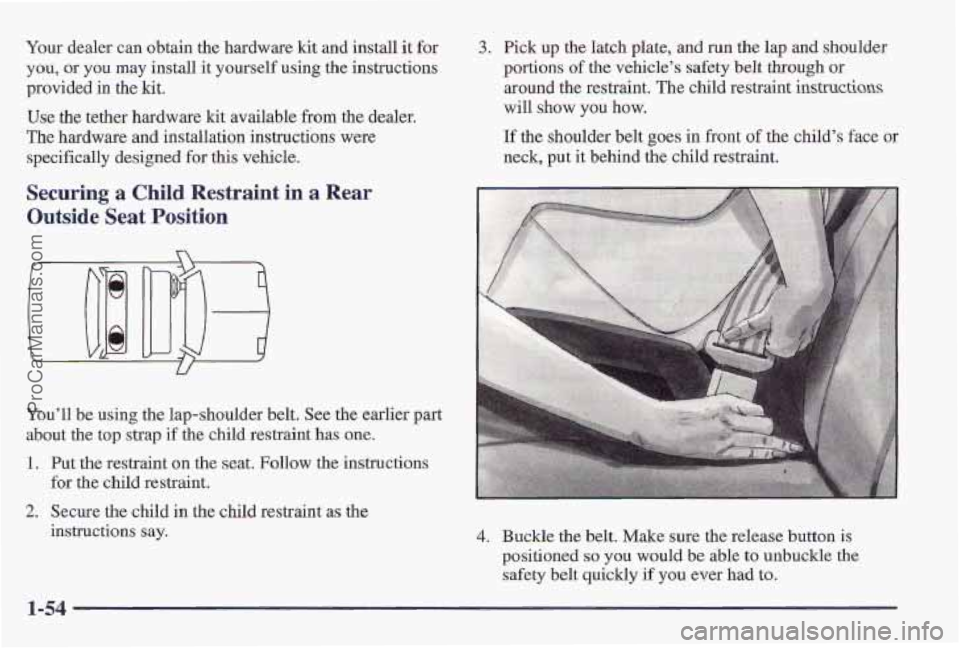
Your dealer can obtain the hardware kit and install it for
you, or
you may install it yourself using the instructions
provi’ded in
the kit.
Use the tether hardware kit available from the dealer.
The hardware and installation instructions were
specifically designed
for this vehicle.
Securing a Child Restraint in a Rear
Outside Seat
Position
You’ll be using the lap-shoulder belt. See the earlier part
about the top strap if the child restraint has
one.
1. Put the restraint on the seat. Follow the instructions
2. Secure the child in the child restraint as the
for the child restraint.
instructions
say.
3. Pick up the latch plate, and run the lap and shoulder
portions of the vehicle’s safety belt through or
around the restraint. The child restraint instructions
will show you how.
If the shoulder belt goes in front of the child’s face or
neck, put it behind
the child restraint.
4. Buckle the belt. Make sure the release button is
positioned so you would be able to unbuckle the
safety belt quickly
if you ever had to.
ProCarManuals.com
Page 63 of 419
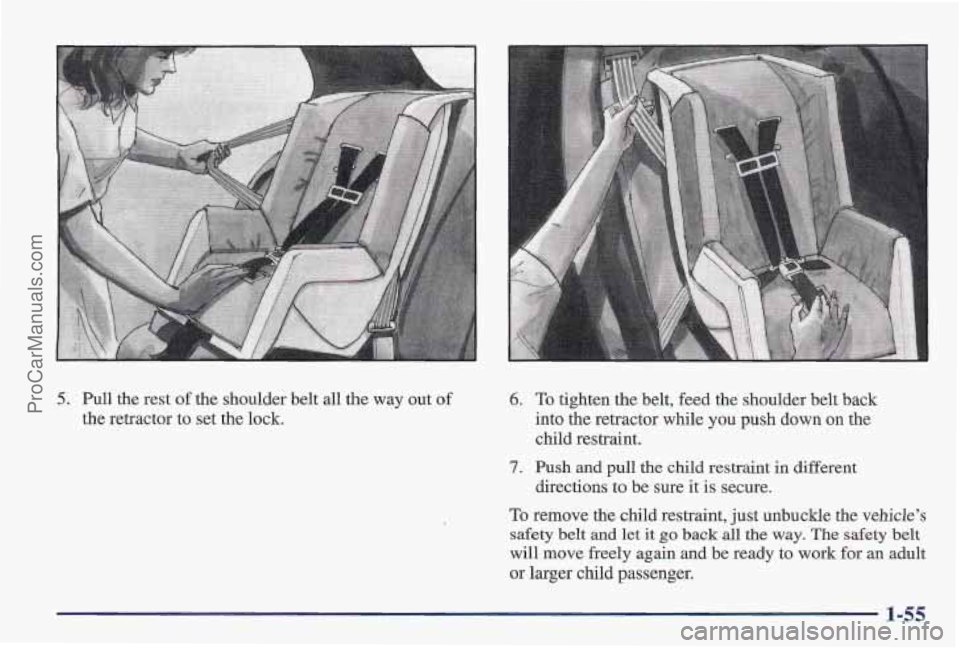
5. Pull the rest of the shoulder belt all the way out of
the retractor to set the lock.
6. To tighten the belt, feed the shoulder belt back
into the retractor while you push down
on the
child restraint.
7. Push and pull the child restraint in different
directions to be sure it is secure.
To remove the child restraint, just unbuckle the vehicle's
safety
belt and let it go back all the way. The safety belt
will move freely again and be ready to work for an adult
or larger child passenger.
1-55
ProCarManuals.com
Page 64 of 419
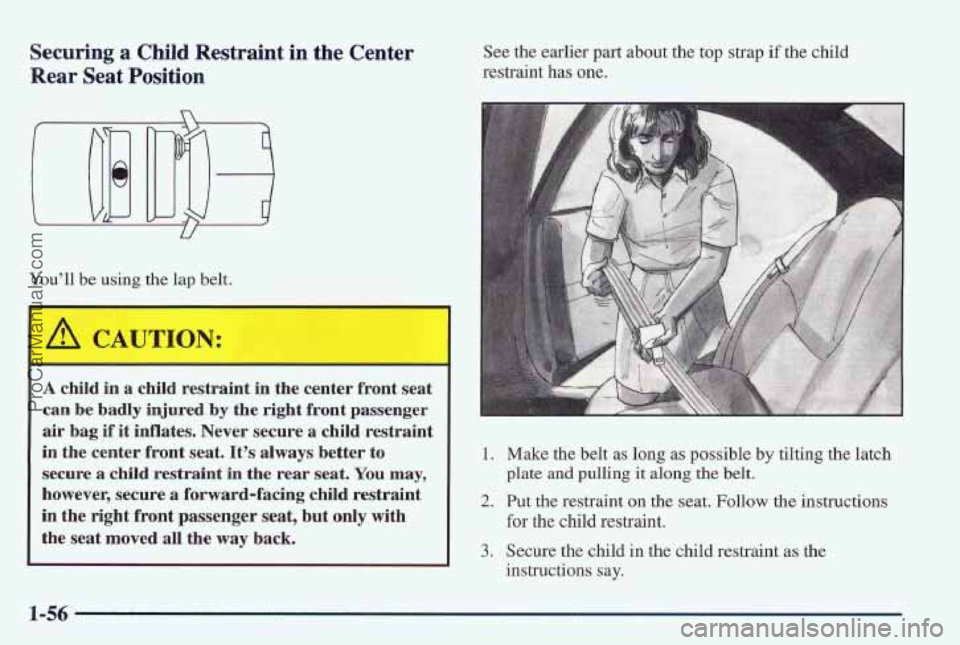
Securing a Child Restraint in the Center
Rear Seat Position
You'll be using the 1aD belt.
-
A CN JTION:
See the earlier part about the top strap if the child
restraint
has one.
~ ~~~~~~ ~~~~~ ~~~
A child in a child restraint in the center front seat
can
be badly injured by the right front passenger
air bag
if it inflates. Never secure a child restraint
in the center front seat. It's always better to
secure a
child restraint in the rear seat. You may,
however,
secure a forward-facing child restraint
in the right front passenger
seat, but only with
the seat moved all the way back.
1. Make the belt as long as possible by tilting the latch
plate
and pulling it along the belt.
2. Put the restraint on the seat. Follow the instructions
for the child restraint.
3. Secure the child in the child restraint as the
instructions say.
1-56
ProCarManuals.com
Page 65 of 419
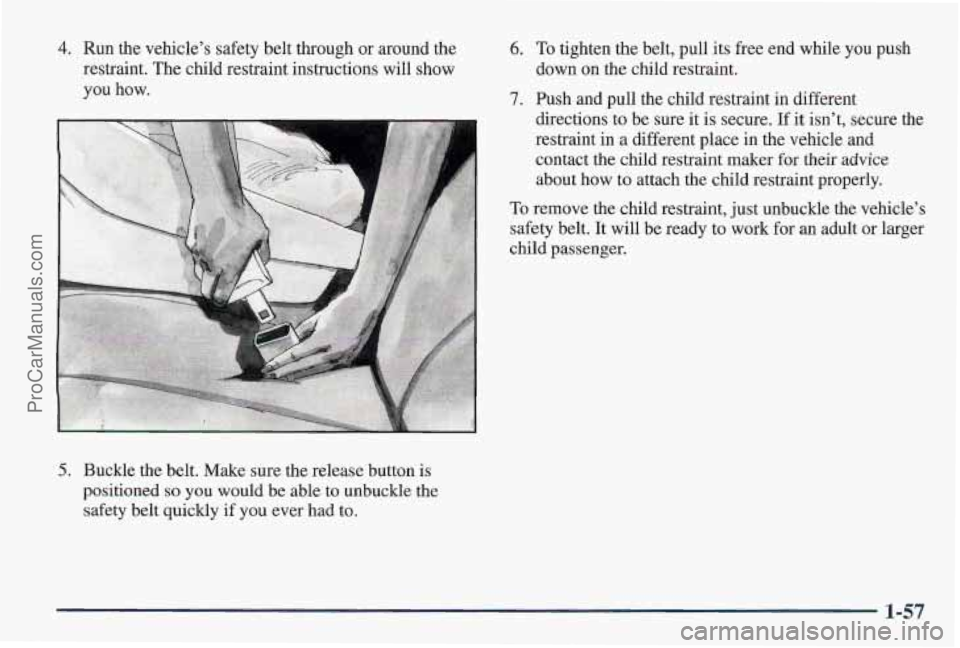
4. Run the vehicle’s safety belt through or around the
restraint. The child restraint instructions will show
you how.
5. Buckle the belt. Make sure the release button is
positioned so you would be able to unbuckle the
safety belt quickly if you ever had to.
6. To tighten the belt, pull its free end while you push
down on the child restraint.
7, Push and pull the child restraint in different
directions to be sure it
is secure. If it isn’t, secure the
restraint in a different place in the vehicle and
contact the child restraint maker for
their advice
about how to attach the child restraint properly.
To remove the child restraint, just unbuckle the vehicle’s
safety belt. It will be ready
to work for an adult or larger
child passenger.
1-57
ProCarManuals.com
Page 66 of 419
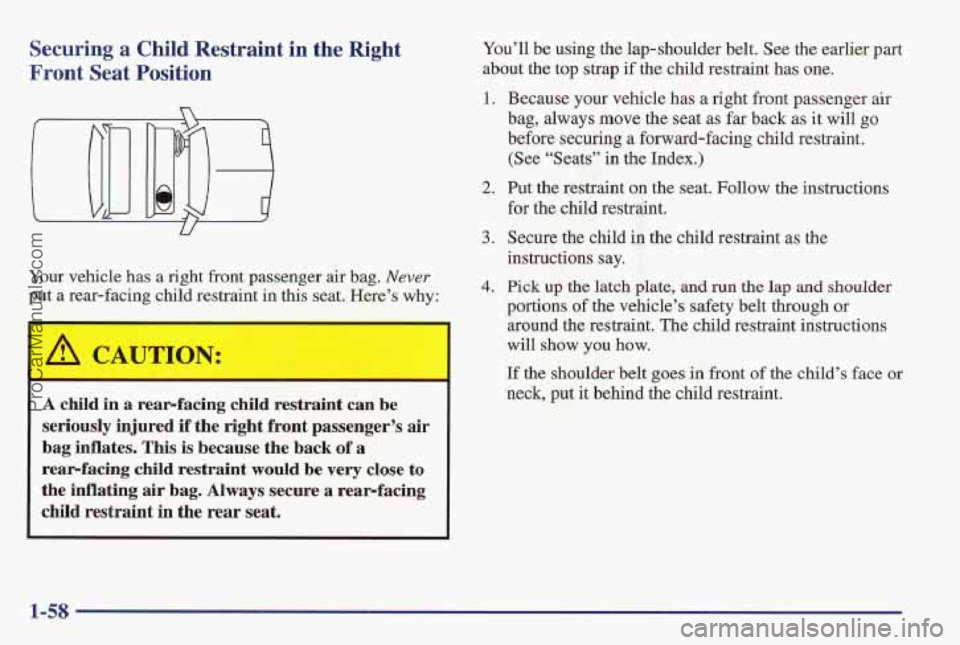
Securing a Child Restraint in the Right
Front Seat Position
Y
Your vehicle has a right front passenger air bag. Never
put a rear-facing child restraint in this seat. Here’s why:
A child in a rear-facing child restraint can be
seriously injured if the right front passenger’s air
bag inflates. This is because the back
of a
rear-facing child restraint would
be very close to
the inflating air bag. Always secure a rearfacing
child restraint
in the rear seat.
You’ll be using the lap-shoulder belt. See the earlier part
about the top strap if the child restraint has one.
1.. Because your vehicle has a right front passenger air
bag, always move the s’eat as far back as it will go
before securing a forward-facing child restraint.
(See “Seats” in the Index.)
2. Put the restraint on the seat. Follow the instructions
for the child restraint.
3. Secure the child in the child restraint as the
instructions say.
4. Pick up the latch plate, and run the lap and shoulder
portions of the vehicle’s safety belt through or
around the restraint. The child restraint instructions
will
show you how.
If the shoulder belt goes in front of the child’s face or
neck, put it behind the child restraint.
1-58
ProCarManuals.com
Page 67 of 419
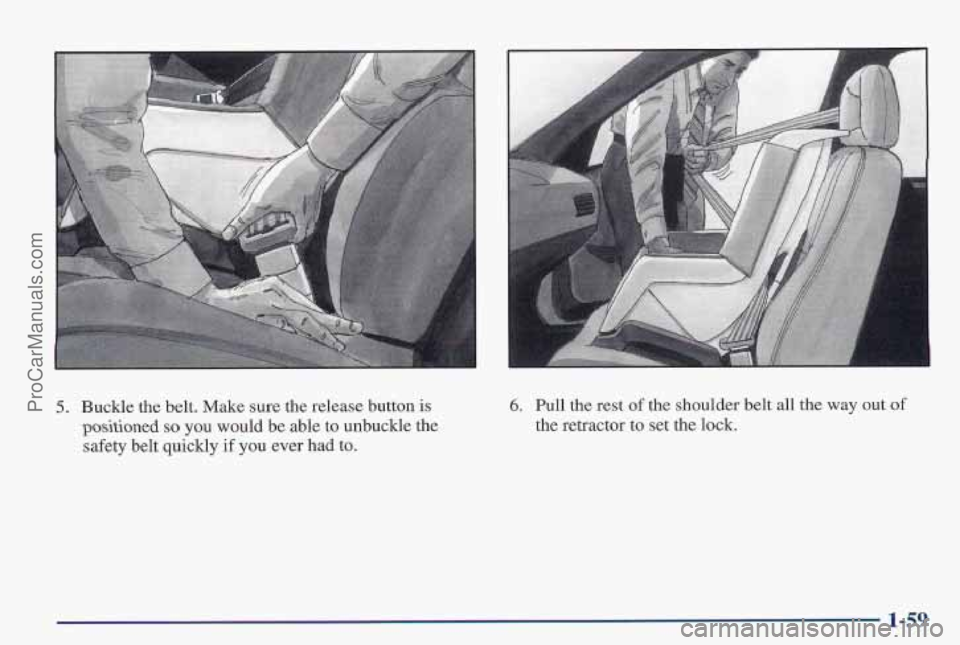
5. Buckle the belt. Make sure the release button is
positioned
so you would be able to unbuckle the
safety belt quickly
if you ever had to.
6, Pull the rest of the shoulder belt all the way out of
the retractor to set the lock.
1-59
ProCarManuals.com
Page 68 of 419
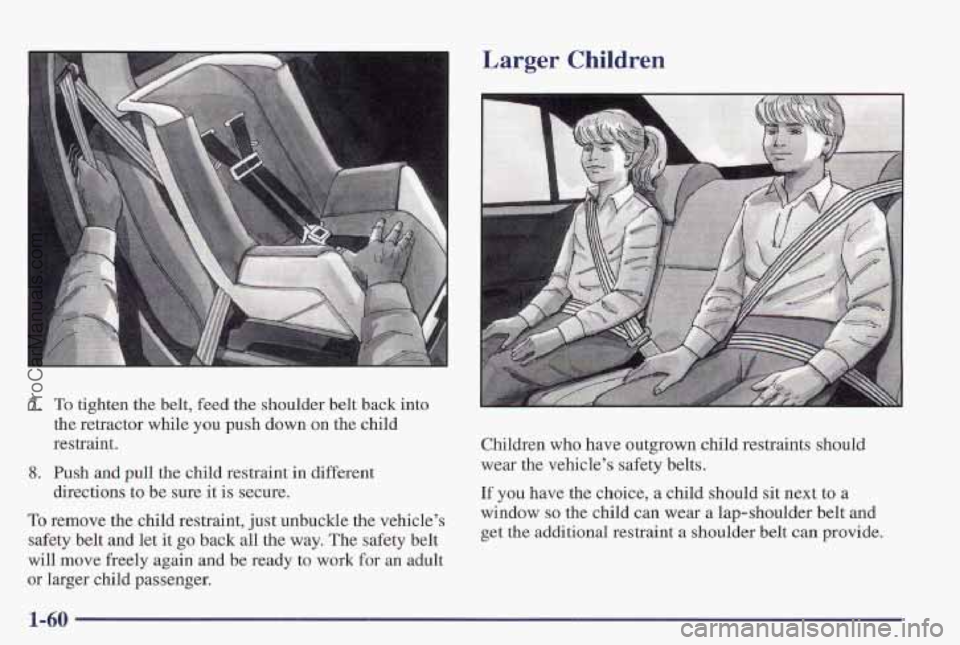
into
Larger Children
7. To tighten the belt, feed the shoulder belt back
the retractor while
you push down on the child
restraint.
8. Push and pull the child restraint in different
directions
to be sure it is secure.
To remove the child restraint, just unbuckle the vehicle’s
safety belt and let
it go back all the way. The safety belt
will move freely again and be ready to
work for an adult
or larger child passenger. Children who
have outgrown child restraints should
wear the vehicle’s safety belts.
If you have the choice, a child should sit next to a
window
so the child can wear a lap-shoulder belt and
get the additional restraint
a shoulder belt can provide.
1-60
ProCarManuals.com
Page 69 of 419
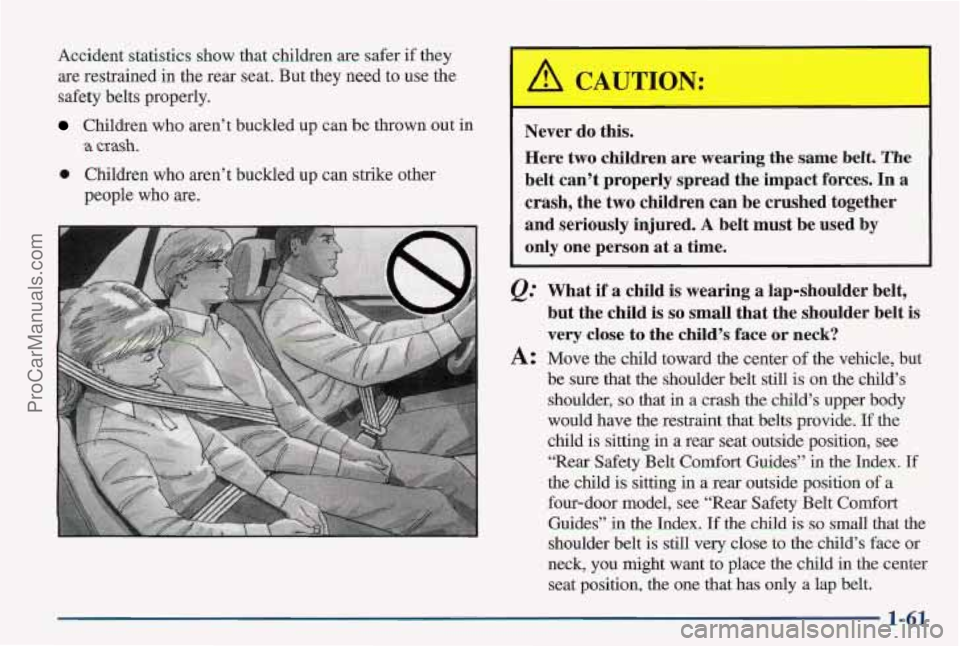
Accident statistics show that children are safer if they
are restrained in the rear seat. But they need to use the
safety belts properly.
Children who aren’t buckled up can be thrown out in
a crash.
0 Children who aren’t buckled up can strike other
people who
are.
Never do this.
Here two children are wearing the same
belt. The
b’elt can’t properly spread the impact forces. In a
crash, the
two children can be crushed together
and seriously injured.
A belt must be used by
only one person
at a time.
Q.” What if a child is wearing a lap-shoulder belt,
but the child
is so small that the shoulder belt is
very close to the child’s face or neck?
A: Move the child toward the center of the vehicle, but
be sure that the shoulder belt still is on
the child’s
shoulder,
so that in a crash the child’s upper body
would have the restraint that belts provide. If the
child is sitting in a rear seat outside position, see
“Rear Safety Belt
Comfort Guides” in the Index. If
the child is sitting in a rear outside position of a
four-door model, see “Rear Safety Belt
Comfort
Guides” in the Index. If the child is so small that the
shoulder belt is still very close to
the child’s face or
neck, you might want
to place the child in the center
seat position, the one that has only
a lap belt.
1-61
ProCarManuals.com
Page 70 of 419
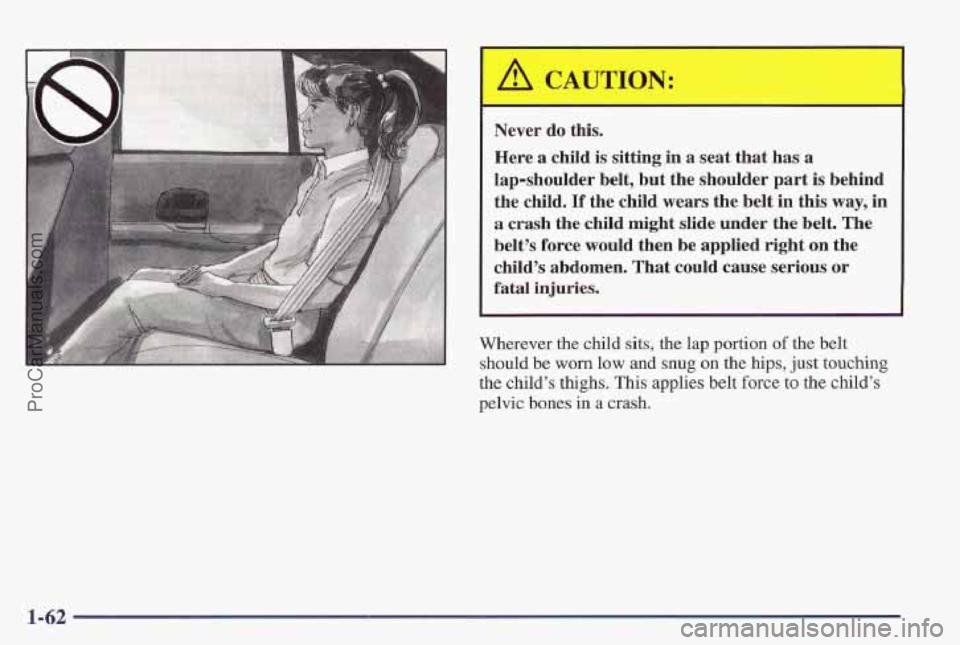
Here a child is sitting in a seat that has a
lap-shoulder belt, but the shoulder part
is behind
the child.
If the child wears the belt in this way, in
a crash the child might slide under the belt. The
belt’s force would then be applied right on the
child’s abdomen. That could cause serious or
fatal
injuries.
Wherever the child sits, the lap portion of the belt
should be
worn low and snug on the hips, just touching
the child’s thighs. This applies belt force to the child’s
pelvic bones
in a crash.
1-62
ProCarManuals.com